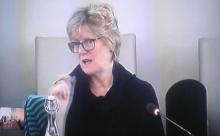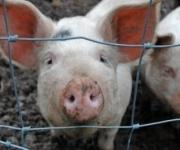In this case, human mortality due to antibiotic resistance, which is caused by the use of animal products that have been grown with the use of antibiotics, can become higher than from cancer. Such data was expressed by British experts in the framework of the London conference on threats of antimicrobial resistance. The specialists of the USBA visited an online broadcast of this conference.
On September 21, 2018 experts of the Ukrainian Stock Breeders Association visited an online conference dedicated to the problem of antimicrobial resistance (AMR), organized by the European Bank for Reconstruction and Development and Aviva Investors.
The event was held in London and broadcasted online for more than a dozen European countries, including Kyiv, at the EBRD's main office.
At the conference an extremely important issue was raised - the widespread use of antibiotics in agriculture, which causes a number of negative consequences for both animals and humans who consume products of animal origin, namely, resistance to antimicrobial therapy makes it impossible to effectively treat many diseases and even leads to a lethal outcome.
АМР is a growing public health problem, and it covers all areas of health, pharmaceuticals, agribusiness and food - the regions in which the EBRD and Aviva Investors are actively investing - this is the basic postulate of the conference.
Therefore, in particular, according to Dame Sally Davis, the head of the Department of Health of England, who was the main speaker at the conference, every year from the consequences associated with antimicrobial resistance, almost 700 000 people die in the world (compared to cancer - 8,200,000, in the car accident - 1200000 people).
If the situation does not change in a positive way, then, according to expert estimates, by 2050, the annual mortality from the effects of antimicrobial resistance will increase to 10 million people/year, that is, more than people die from cancer today.
In addition, AMR can cause significant and global expenditure on health, economic and social costs.
Dame Sally Davis points out that there should be a comprehensive approach in the fight against excessive use of antimicrobial therapy. The problem should be treated responsibly at all levels: pharmaceutical companies, food industry, politicians, investors, farmers, legislators and, indeed, society itself.
What do we have now?
Less than 5% of all funds, which are allocated in the development of pharmaceuticals, were invested for the development of the alternative antimicrobial industry from 2003 to 2013.
From animal to man
The speaker noted that 2/3 of all world production of antibiotics is used in livestock. At the same time, 75% of cases of their use are not used for medicinal purposes.
Thus, the use of food of animal origin has antimicrobial resistance in humans.
As a result, the speaker sums up that humanity is at risk of losing modern methods of treatment.
What to do?
Dame Sully Davis noted the following important points in the fight against the problem:
• Modern medications are exhausted, new drugs with a long expiration date are needed. It is needed to:
1. Increase investment in antimicrobial research and development
2. Competent introduction of the data of innovative developments in production
In the agricultural sector, it is needed to:
• Stop the use of antibiotics to stimulate growth and metaphylaxis
• Improve biosafety
• Increase the use of vaccination
The food industry should promote the proper use of antibacterial drugs in its supply networks and provide transparent information on the availability of antibiotics in food products.
In addition to the speech of the main speaker, round tables were also held at the conference with the participation of representatives of the private sector, civil society organizations and AMR international experts. The issues related to the role of investors and industries where discussed there to solve AMP situations.















 Лобіювання інтересів тваринників в органах виконавчої влади
Лобіювання інтересів тваринників в органах виконавчої влади Участь в науково-практичних заходах Асоціації із залученням європейських експертів світового рівня
Участь в науково-практичних заходах Асоціації із залученням європейських експертів світового рівня Щотижневий огляд тенденцій та прогнозів розвитку тваринницької галузі
Щотижневий огляд тенденцій та прогнозів розвитку тваринницької галузі